Autopsia in Abstentia: The Continued Collapse of Chernobyl
A post-mortem examination of a post-nuclear landscape
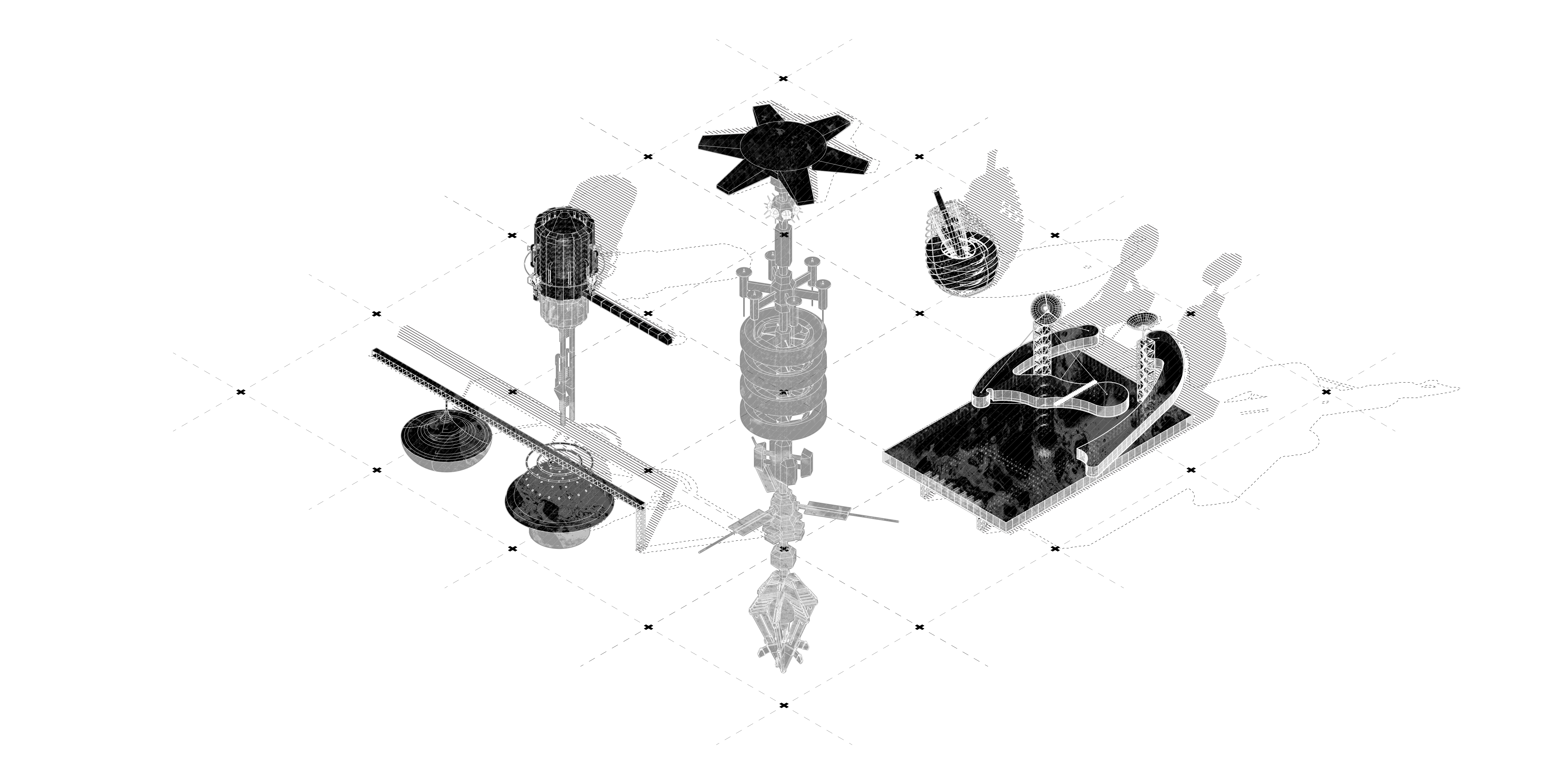
Adaptive Apparatus
Chernobyl, Ukraine
Special thanks to thesis advisor El Hadi Jazairy (Design Earth).
[Achievements]
- Burton L. Kampner Memorial Award for most outstanding thesis project
- Nominated for Taubman College’s annual “Superjury” review
- Featured on SuckerPunch
- Featured on Study Architecture
- Recording of final presentation for Superjury
- Recording of Superjury award symposium (award given at 37:19)
This thesis explores the complicated history and identity crisis of Chernobyl and examines its post-mortem reality through ameliorative apparatus that allow it to heal from its trauma. It investigates the death or fallout of an event while not being present at it by using the remnants and traces of its existence. This has helped create a profound framework focused on process and factors of time, allowing for the embedding of five specific interventions that react and respond to the pain of the existing environment: Radiosynthetic Needle, Bioremedial Bubbles, Reverse Repository, Half-Life Lab, and Carbo Conclusus.
Additionally, it explores the cultural and social repercussions of collapse, the phenomenon that rids landscapes of their use and identity, and looks towards leveraging them to become acts of renewal and rebirth. This is done by examining the past, present, and future as both a compound whole and as non-linear parts. By doing so, the micro and macro infrastructures exist between states of the man-made and the natural, a heterotopic in-between that allows the invisible processes and relationships within Chernobyl to become visible. Events that unfold in one time period produces drastic effects for the other time periods, allowing for an omniscient narration that takes into consideration varying states of decay or growth that influence and derive from one another.
![]()
On April 26th, 1986, a safety test on the backup cooling system of reactor #4 at the Chernobyl Nuclear Power Plant in northern Ukraine was deemed so routine that the plant’s director didn’t even bother showing up. However, it quickly spiraled out of control as an unexpected power surge and steam buildup led to a series of explosions that blew apart one of four reactors. Considered history’s worst nuclear accident, the Chernobyl disaster released an unfathomable amount of radiation in the atmosphere, and killed 31 people directly, including 28 workers and firefighters who died of acute radiation poisoning during the cleanup. Experts believe it likewise caused tens of thousands of premature deaths related to cancer throughout all of Europe, though the exact number is disputed and actively hidden by the government. To this day, the area around the plant remains so contaminated that it is officially closed off to human habitation and the plant itself is covered by a steel sarcophagus. The site now functions as a critical area of horror that is riddled with complicated memories of pain and guilt.
![]()
![]()
The ruins that have resulted from the neglect and malfeasance of the region have become voids, or sociological blind spots. These voids act as petrified reminders of an overwhelming trauma that challenge any desire to forget, rupturing symbolic worlds and social order. In Chernobyl, all sites of trauma or ruins point to an absence that can never be overcome, but an absence that nevertheless must be acknowledged if healing is to take place.
![]()
![]()
However, there is a new movement of dark tourism that can be understood as an enabler of decay and its simultaneous fetishization is problematic. Visitors are flocking to sites of tragedy making the worst parts of history a portion, if not the whole point, of their vacations. As seen by these photos of tourists posing in front of derelict structures, this movement aestheticizes struggle without inquiring of its origin, exploits spaces but never seeks out the people that actually inhabit and transform them, and romanticizes isolated acts of resistance or destruction without acknowledging the massive political and social forces that are aligned against the real transformation of a landscape.
This speculative story of optimism begins in 2019. Recently discovered in the walls of the haunted nuclear power plant is a species of radiotrophic fungus that “eats” radiation. By utilizing its vast amounts of melanin, it can convert radiation into chemical energy for growth. In other words, rather than relying on photosynthesis, the fungi have adapted to the irradiated ruins and developed a new way to survive, dubbed “radiosynthesis”. This newfound retaliatory method inspires visions of radioculture, or post-nuclear agriculture, and the potential of creating an evolutionary landscape and reactive tools that actively respond to nuclear threats by merging organic life with material ruin. This application of bioremediation has the potential to mesh the artificial, natural, and political and can initiate the healing process that the radiated temporal and spatial qualities of post-nuclear nature and society desperately face.
![]()
While it is impossible to create a perfect, singular representation of Chernobyl due to its incredibly complex fabric, it is important to establish a dialogue between witnesses, victims, experiences, and memories into one narrative of solidarity as opposed to hostility. Inspired by Isabella Kirkland’s “Gone”, the triptych above began as a means of exploring three significant mnemonic sites that function as fractured realities that acknowledge pain, guilt, and post-nuclear nature: the destroyed reactor, the memorials of victims, and the nuclear city of Pripyat. The three reveal and represent how cityscapes might decay when/if abandoned, while additionally documenting the failure of the Soviet state, the invisible and underlying issues of miscommunication and storytelling, and the multiple perceptions and reconstructions of the visual landscape of a single event.
![]()
Autopsia in Abstentia situates itself in the year 2052. The Chernobyl catastrophe has stylized the landscape, turning it into a stage for the world to gaze upon. What counts now is to capture the “spectacle of reality” by utilizing old memories to design an evolutionary landscape that keeps the structure of heavy industry to better understand it, while also providing a transformative second life.
![]()
![]()
By assembling an open landscape system made of diverse interventions in close proximity to the Power Plant, Autopsia in Abstentia is able to focus on re-working and appropriating a set of conditions that affect the local, environmental, and bio-political. Each of the five interventions target existing issues where the experience of beauty and peace is complicated by the memory and knowledge of human’s impact on nature and work together as a larger system that examine the possibility of co-habitation and co-existence. The specific conditions or issues that are targeted include nuclear destruction, nuclear waste, memory and storage, information and monitoring, and carbon capture. These apparatuses vary in scale and scope in order to better comprehend the magnitude and severity of nuclear collapse by fragmenting the site into understandable bits. By fusing high-technology with high-typology, the interventions work in tandem and achieve synchronicity between artificial and natural as opposed to obstructing each other’s goals, resulting in an industrial idyll that uncovers and stimulates the autopsy of collapse.
Chernobyl, Ukraine
Special thanks to thesis advisor El Hadi Jazairy (Design Earth).
[Achievements]
- Burton L. Kampner Memorial Award for most outstanding thesis project
- Nominated for Taubman College’s annual “Superjury” review
- Featured on SuckerPunch
- Featured on Study Architecture
- Recording of final presentation for Superjury
- Recording of Superjury award symposium (award given at 37:19)
This thesis explores the complicated history and identity crisis of Chernobyl and examines its post-mortem reality through ameliorative apparatus that allow it to heal from its trauma. It investigates the death or fallout of an event while not being present at it by using the remnants and traces of its existence. This has helped create a profound framework focused on process and factors of time, allowing for the embedding of five specific interventions that react and respond to the pain of the existing environment: Radiosynthetic Needle, Bioremedial Bubbles, Reverse Repository, Half-Life Lab, and Carbo Conclusus.
Additionally, it explores the cultural and social repercussions of collapse, the phenomenon that rids landscapes of their use and identity, and looks towards leveraging them to become acts of renewal and rebirth. This is done by examining the past, present, and future as both a compound whole and as non-linear parts. By doing so, the micro and macro infrastructures exist between states of the man-made and the natural, a heterotopic in-between that allows the invisible processes and relationships within Chernobyl to become visible. Events that unfold in one time period produces drastic effects for the other time periods, allowing for an omniscient narration that takes into consideration varying states of decay or growth that influence and derive from one another.

On April 26th, 1986, a safety test on the backup cooling system of reactor #4 at the Chernobyl Nuclear Power Plant in northern Ukraine was deemed so routine that the plant’s director didn’t even bother showing up. However, it quickly spiraled out of control as an unexpected power surge and steam buildup led to a series of explosions that blew apart one of four reactors. Considered history’s worst nuclear accident, the Chernobyl disaster released an unfathomable amount of radiation in the atmosphere, and killed 31 people directly, including 28 workers and firefighters who died of acute radiation poisoning during the cleanup. Experts believe it likewise caused tens of thousands of premature deaths related to cancer throughout all of Europe, though the exact number is disputed and actively hidden by the government. To this day, the area around the plant remains so contaminated that it is officially closed off to human habitation and the plant itself is covered by a steel sarcophagus. The site now functions as a critical area of horror that is riddled with complicated memories of pain and guilt.


The ruins that have resulted from the neglect and malfeasance of the region have become voids, or sociological blind spots. These voids act as petrified reminders of an overwhelming trauma that challenge any desire to forget, rupturing symbolic worlds and social order. In Chernobyl, all sites of trauma or ruins point to an absence that can never be overcome, but an absence that nevertheless must be acknowledged if healing is to take place.


However, there is a new movement of dark tourism that can be understood as an enabler of decay and its simultaneous fetishization is problematic. Visitors are flocking to sites of tragedy making the worst parts of history a portion, if not the whole point, of their vacations. As seen by these photos of tourists posing in front of derelict structures, this movement aestheticizes struggle without inquiring of its origin, exploits spaces but never seeks out the people that actually inhabit and transform them, and romanticizes isolated acts of resistance or destruction without acknowledging the massive political and social forces that are aligned against the real transformation of a landscape.
This speculative story of optimism begins in 2019. Recently discovered in the walls of the haunted nuclear power plant is a species of radiotrophic fungus that “eats” radiation. By utilizing its vast amounts of melanin, it can convert radiation into chemical energy for growth. In other words, rather than relying on photosynthesis, the fungi have adapted to the irradiated ruins and developed a new way to survive, dubbed “radiosynthesis”. This newfound retaliatory method inspires visions of radioculture, or post-nuclear agriculture, and the potential of creating an evolutionary landscape and reactive tools that actively respond to nuclear threats by merging organic life with material ruin. This application of bioremediation has the potential to mesh the artificial, natural, and political and can initiate the healing process that the radiated temporal and spatial qualities of post-nuclear nature and society desperately face.

While it is impossible to create a perfect, singular representation of Chernobyl due to its incredibly complex fabric, it is important to establish a dialogue between witnesses, victims, experiences, and memories into one narrative of solidarity as opposed to hostility. Inspired by Isabella Kirkland’s “Gone”, the triptych above began as a means of exploring three significant mnemonic sites that function as fractured realities that acknowledge pain, guilt, and post-nuclear nature: the destroyed reactor, the memorials of victims, and the nuclear city of Pripyat. The three reveal and represent how cityscapes might decay when/if abandoned, while additionally documenting the failure of the Soviet state, the invisible and underlying issues of miscommunication and storytelling, and the multiple perceptions and reconstructions of the visual landscape of a single event.

Autopsia in Abstentia situates itself in the year 2052. The Chernobyl catastrophe has stylized the landscape, turning it into a stage for the world to gaze upon. What counts now is to capture the “spectacle of reality” by utilizing old memories to design an evolutionary landscape that keeps the structure of heavy industry to better understand it, while also providing a transformative second life.

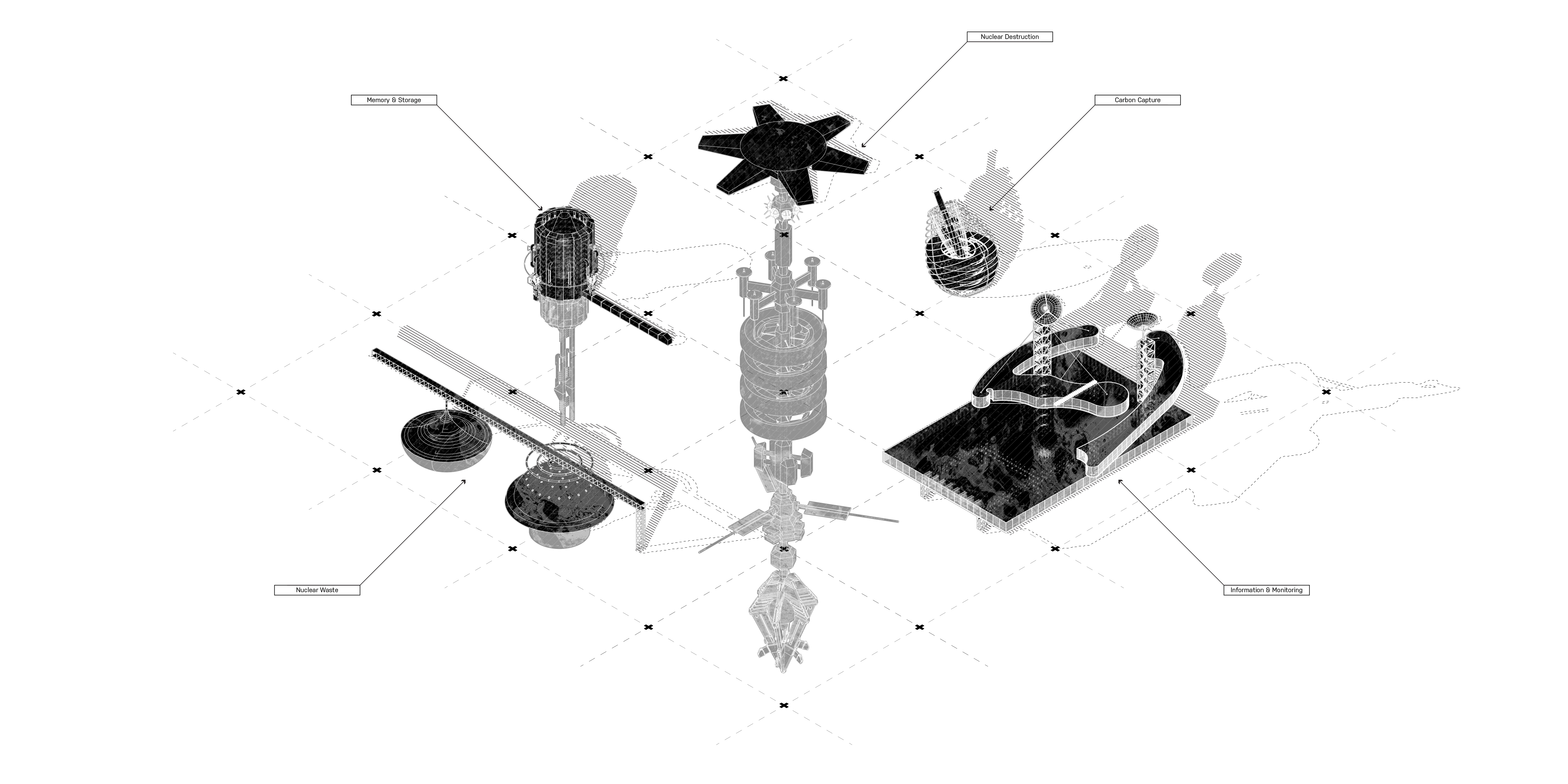
By assembling an open landscape system made of diverse interventions in close proximity to the Power Plant, Autopsia in Abstentia is able to focus on re-working and appropriating a set of conditions that affect the local, environmental, and bio-political. Each of the five interventions target existing issues where the experience of beauty and peace is complicated by the memory and knowledge of human’s impact on nature and work together as a larger system that examine the possibility of co-habitation and co-existence. The specific conditions or issues that are targeted include nuclear destruction, nuclear waste, memory and storage, information and monitoring, and carbon capture. These apparatuses vary in scale and scope in order to better comprehend the magnitude and severity of nuclear collapse by fragmenting the site into understandable bits. By fusing high-technology with high-typology, the interventions work in tandem and achieve synchronicity between artificial and natural as opposed to obstructing each other’s goals, resulting in an industrial idyll that uncovers and stimulates the autopsy of collapse.
Radiosynthetic Needle
A System of ProtectionNuclear disasters annihilate all traces of identity-driven spaces, forcing the environment to be caught between states of heterotopia and reality at the same time. Now existing on the edge of nostalgia, these evidence fields that once yielded multispecies and multicultural life have lost their mosaic of temporal arcs and spatial rhythms. Nothing can be done except to wait thousands of years for the planet to slowly heal from its wounds. This intervention, embedded deep in the radiated landscape, proposes an adaptive apparatus that expedites the long healing process at the hyperobject scale through various mechanical processes that target contaminated environments through geo-engineering.
Imagining the landscape as a body in pain, the system resembles a thin needle that pierces the earth and stimulates a healing response through the Pripyat river, relieving Chernobyl of its dysphoria. The benefit of a vertical organization allows for multiple responses to occur simultaneously, each affecting a separate stratum of the earth. A magnetic field in the form of an umbrella shields communities from radioactive rays, deflecting them in directions that avoid organic life. A preventative measure in the form of polar arrayed dosimeters scans worldwide channels in search of abnormal radiation levels. A rotating axel generates biological reductive agents that are dispersed towards tagged events and mitigate contamination. These technologies function as an underwater watchtower, scanning the surrounding sites for any potential problematic traces that can be dealt with.
Radiosynthetic Needle imagines how radiation can be actively and aggressively monitored, providing a sense of security for the immediate surroundings of Chernobyl, other current contaminated sites such as Fukushima, and any other dormant or future events.
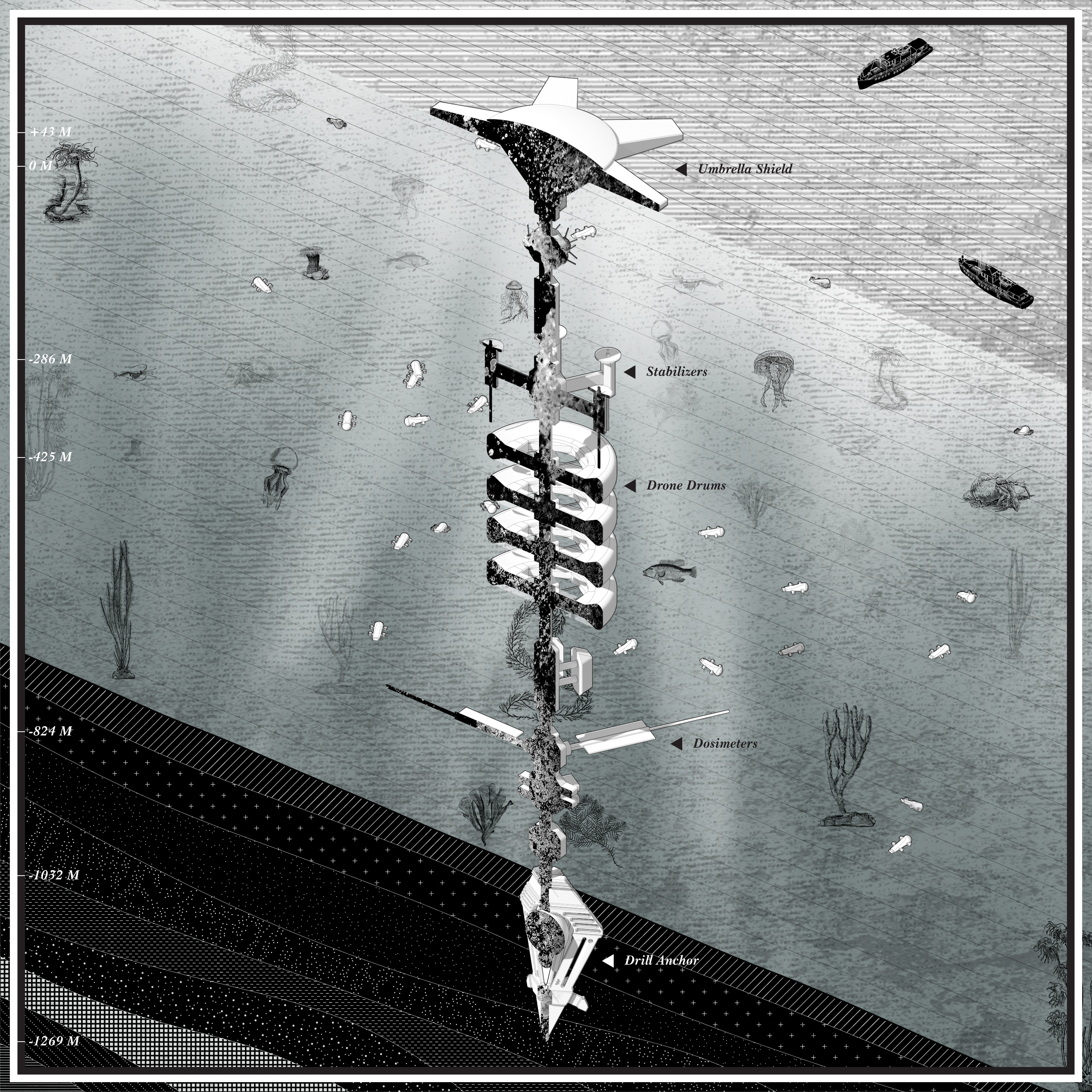
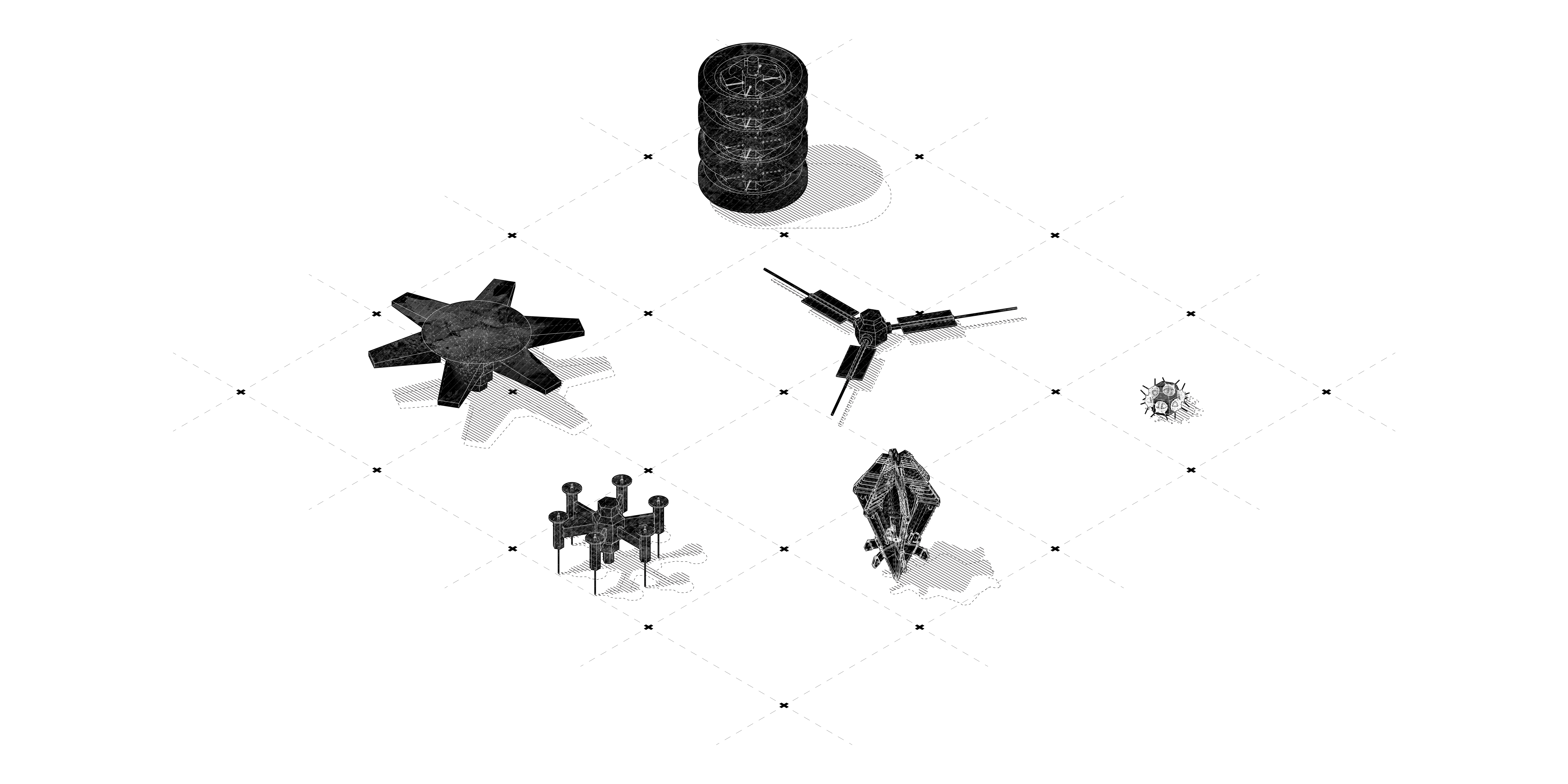


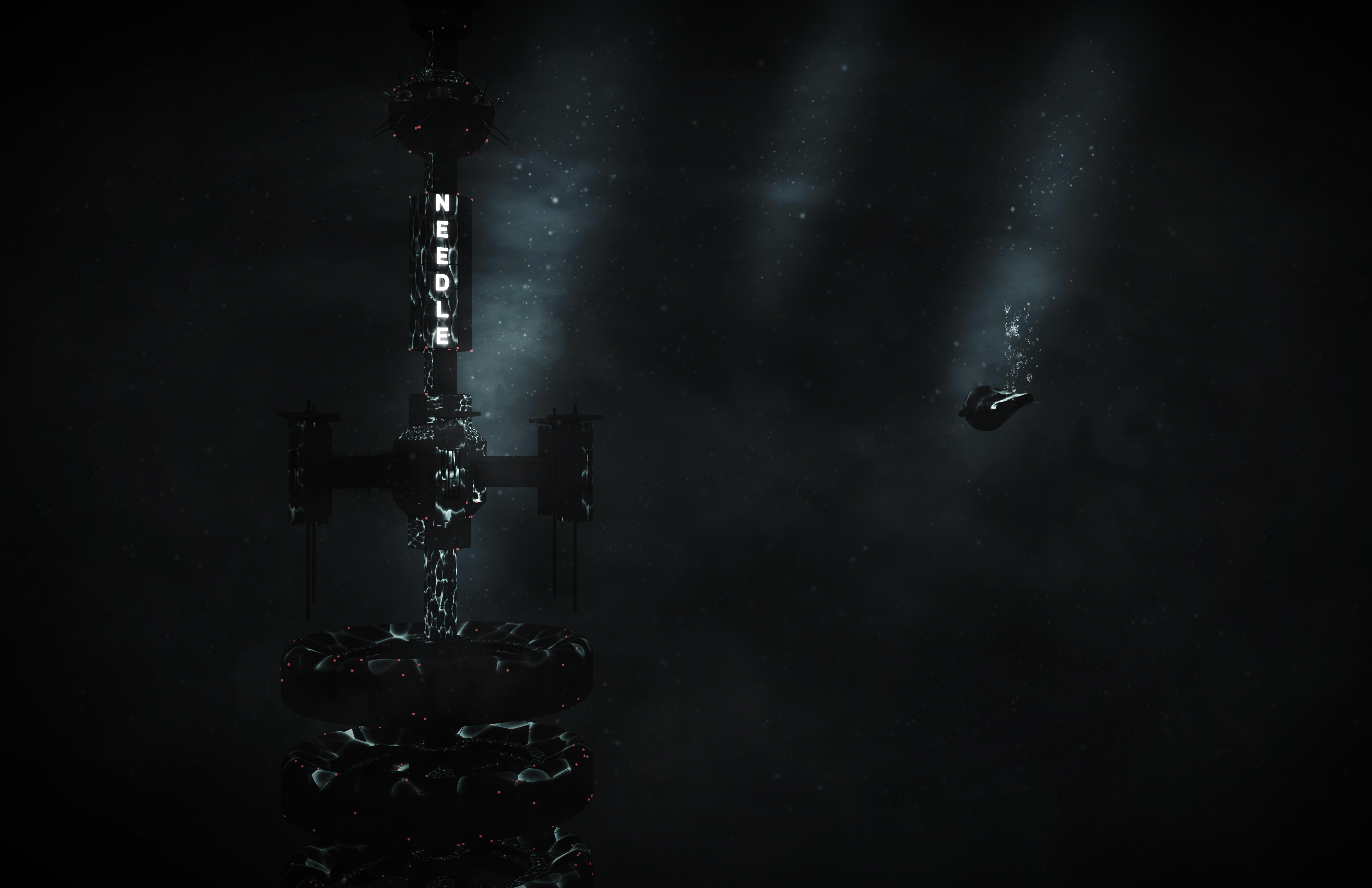
Bioremedial Bubbles
A System of GrowthTransuranic nuclear waste, a byproduct of
nuclear production, is not only harmful but also inutile in that it does not
boast a current means of recycling. Often abandoned in remote and distant
sites, over 250,000 tons of this waste is left to sit idle, unable to produce a
beneficial function for society. This intervention looks at the bioremediation
of radioactive waste and proposes the use of radiotrophic fungi to catalyze
chemical reactions and allow for decontamination, turning the half-life of
harmful radiation into the second life of harmless chemical energy that could
be utilized in local communities as a replacement for unsustainable fossil
fuels.
The intervention supplies two evocative shapes in the landscape, derived from the form of mushrooms and their caps that offers an educational experience for users through bridges and transparent facades. These bubbles grow fungi capable of radiosynthesis through a complicated chain of events. A concrete activation chamber located directly underneath the base of the half-dome hosts nuclear waste, allowing its radiation to contaminate egg-shaped bulbs above. Cryptococcus neoformans, a melanin containing fungi that is stored in the decanter on the left, is macerated by a liquid solution that is then extracted through pneumatic pipes and dropped into nozzles leading into the prepared bulbs, igniting the radiosynthesis process. After several weeks of being housed in a climate-controlled growth sphere, the chemical reaction has taken place and produced a transmuted form of nuclear waste that is useful to future generations.
Bioremediation Bubbles displays the possibilities of a symbiotic coexistence between artificial and natural processes, showing the possibility of life and resilience in the post-nuclear age of the Anthropocene.
The intervention supplies two evocative shapes in the landscape, derived from the form of mushrooms and their caps that offers an educational experience for users through bridges and transparent facades. These bubbles grow fungi capable of radiosynthesis through a complicated chain of events. A concrete activation chamber located directly underneath the base of the half-dome hosts nuclear waste, allowing its radiation to contaminate egg-shaped bulbs above. Cryptococcus neoformans, a melanin containing fungi that is stored in the decanter on the left, is macerated by a liquid solution that is then extracted through pneumatic pipes and dropped into nozzles leading into the prepared bulbs, igniting the radiosynthesis process. After several weeks of being housed in a climate-controlled growth sphere, the chemical reaction has taken place and produced a transmuted form of nuclear waste that is useful to future generations.
Bioremediation Bubbles displays the possibilities of a symbiotic coexistence between artificial and natural processes, showing the possibility of life and resilience in the post-nuclear age of the Anthropocene.




Reverse Repository
A System of Caution
Current containment protocols call for the
storage of millions of barrels of highly radioactive waste in secure
underground chambers 2,150 feet beneath the surface where they remain isolated until
their risk has diminished, which could take up to 100,000 years. This waste is
often transferred into large concrete storage casks where they are then
disposed and stored of in deep geological spaces called repositories. It is
imperative that these sites remain undisturbed for the duration of the decaying
process, in effort to ensure public and environmental safety. This intervention
proposes the memorialization of the traditional underground organization and
ritual of a repository through an above-ground marker that acknowledges the
burial process while additionally warning present, near future, and distant
future visitors of the consequences and dangers it possesses.
The spaces surrounding and leading into the scheme offer an educational means for the public to understand the intellectual journey relating to the nuclear industry and its funeral procession. As they begin to approach the culmination of the site marker, and further stimulated by anechoic qualities and a reorienting sensorial experience, they begin to acknowledge the danger of human intrusion. Symbolized by a massive resonance chamber, the final monument itself actively animates the ideological capacity of the intangible waste hidden far below the earth. Sounds echo throughout the chamber, allowing users to reflect on the afterlife of nuclear waste and the birth of our permanence. The experiential qualities of this monolithic architecture designed for the future, or post-humanity, also functions as an experimental exhibit for the present through a vertical memory wall that contains soil samples and artifacts of nuclear events.
Reverse Repository proposes a perpetual and sentient architecture that outlives chemicals and materials, but not humanity, allowing for the establishment of a relationship between humans and buried nuclear waste that anticipates differing nomenclature.
The spaces surrounding and leading into the scheme offer an educational means for the public to understand the intellectual journey relating to the nuclear industry and its funeral procession. As they begin to approach the culmination of the site marker, and further stimulated by anechoic qualities and a reorienting sensorial experience, they begin to acknowledge the danger of human intrusion. Symbolized by a massive resonance chamber, the final monument itself actively animates the ideological capacity of the intangible waste hidden far below the earth. Sounds echo throughout the chamber, allowing users to reflect on the afterlife of nuclear waste and the birth of our permanence. The experiential qualities of this monolithic architecture designed for the future, or post-humanity, also functions as an experimental exhibit for the present through a vertical memory wall that contains soil samples and artifacts of nuclear events.
Reverse Repository proposes a perpetual and sentient architecture that outlives chemicals and materials, but not humanity, allowing for the establishment of a relationship between humans and buried nuclear waste that anticipates differing nomenclature.

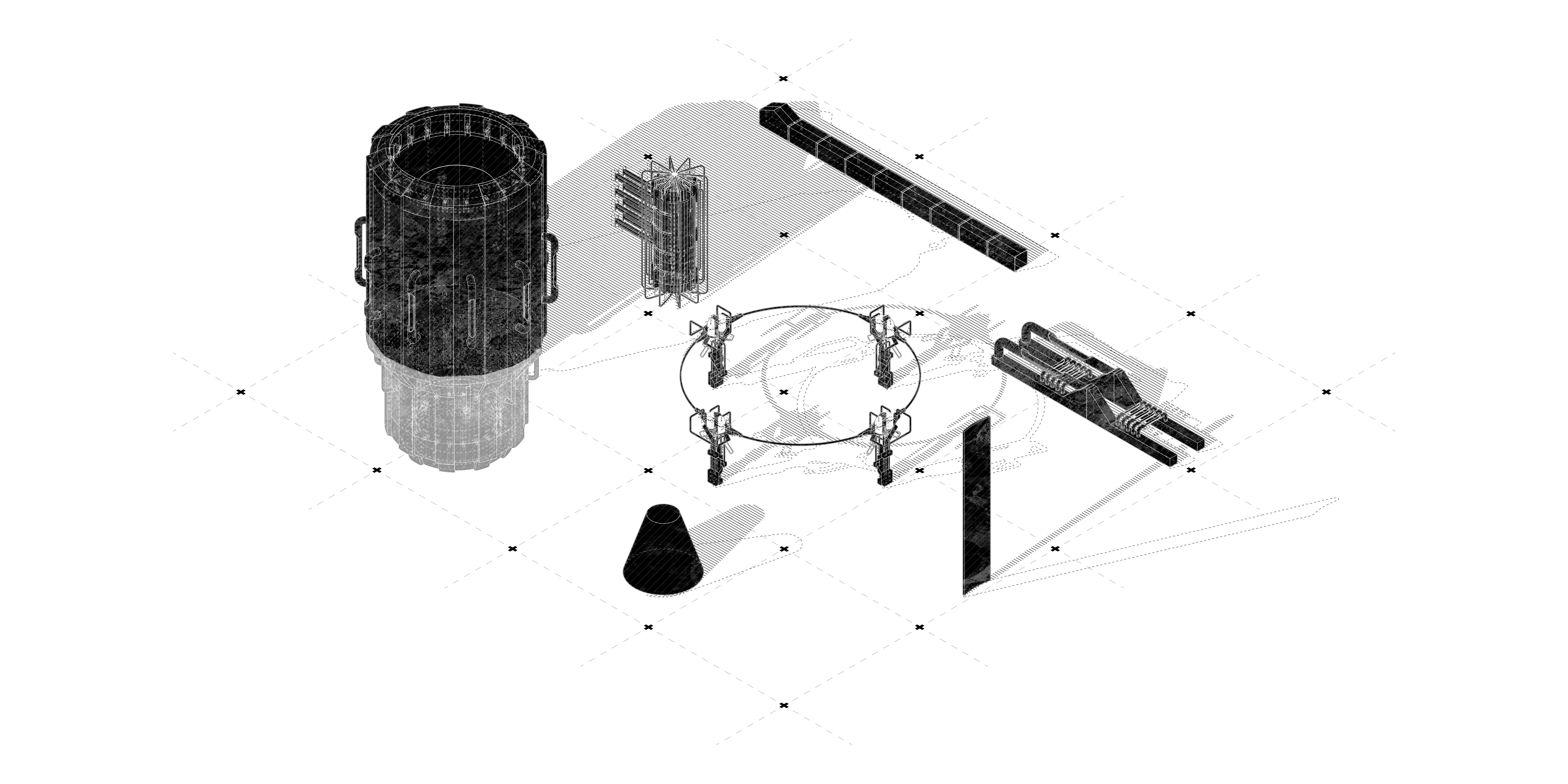
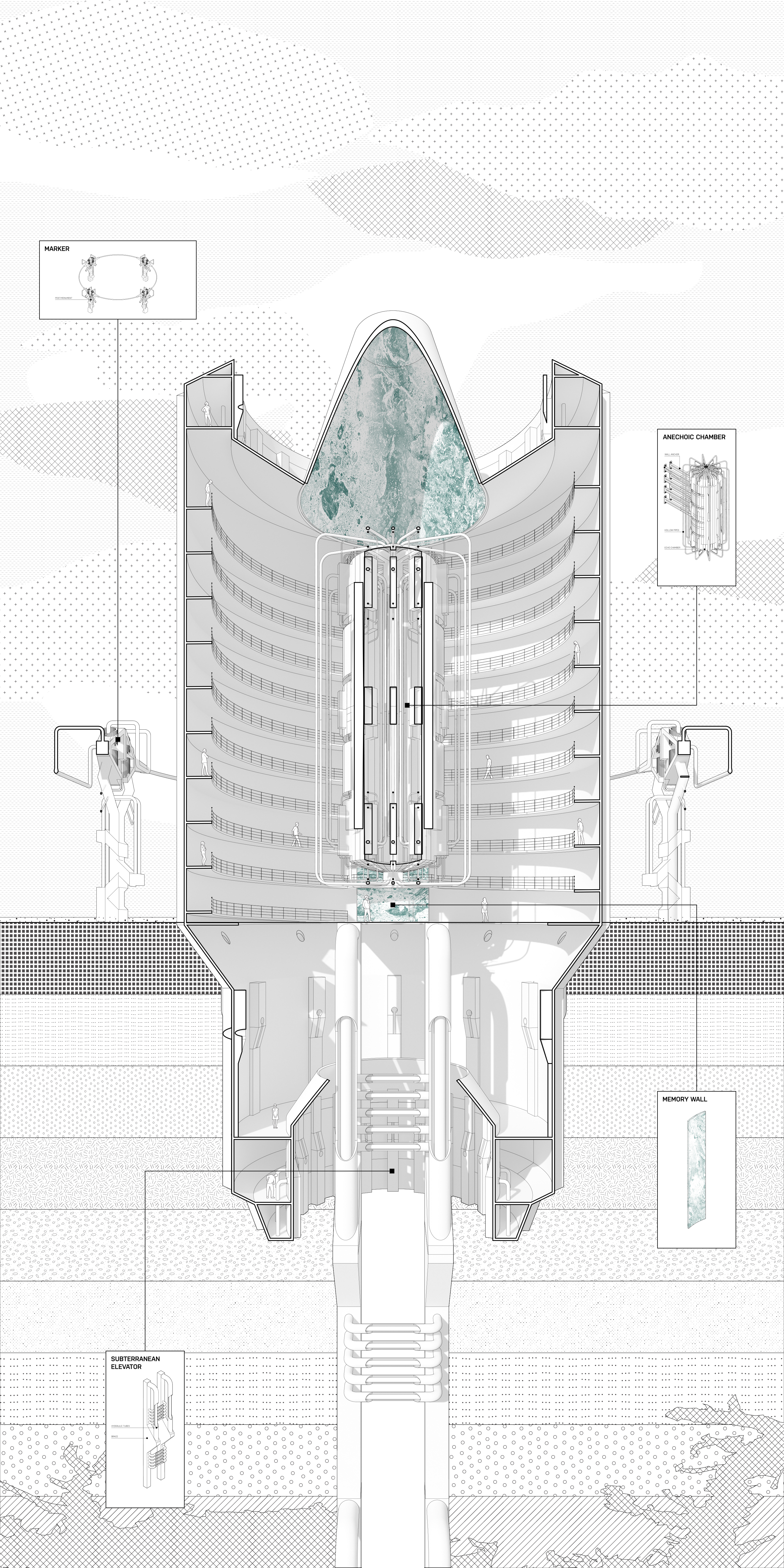
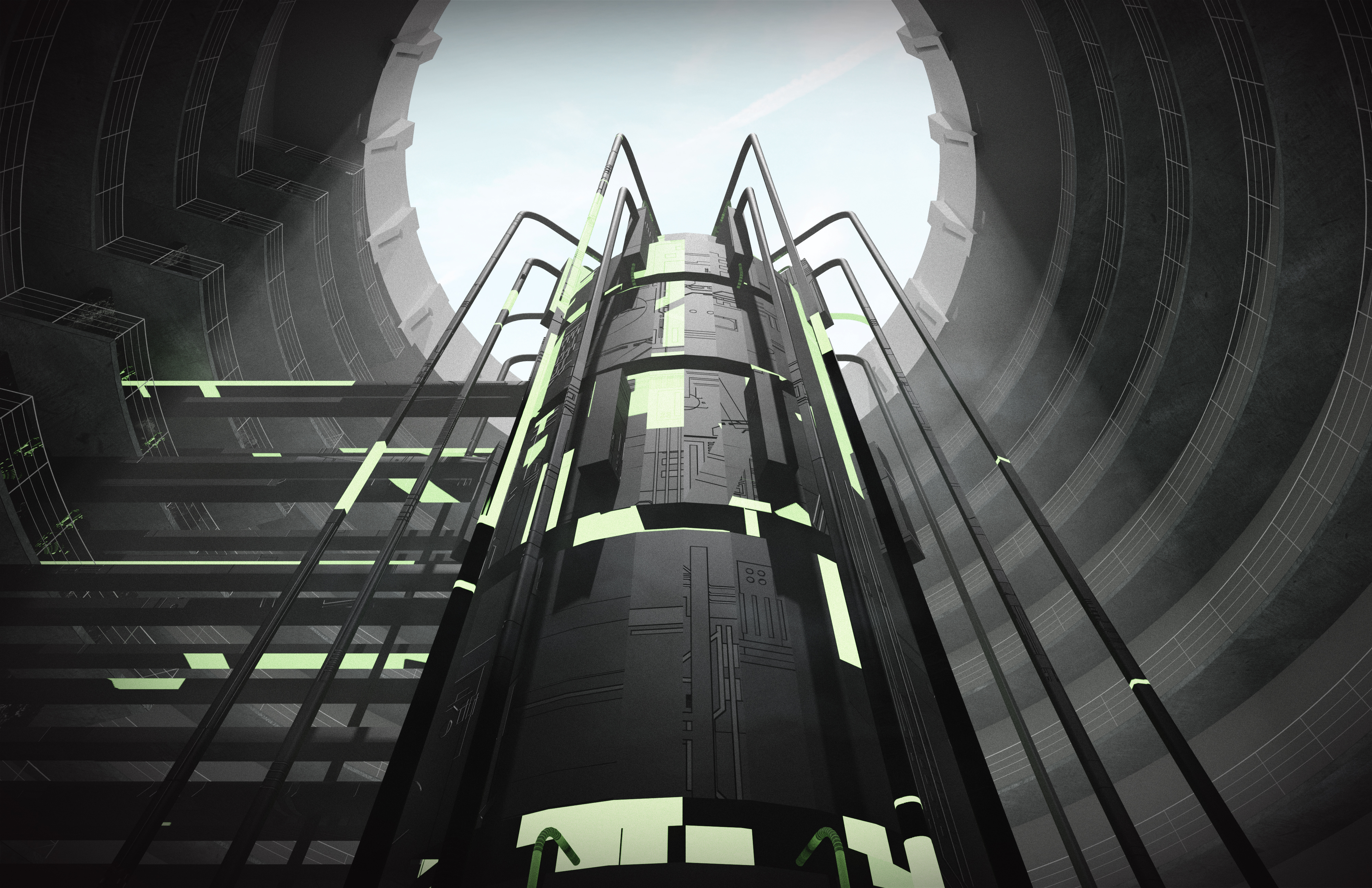
Half-Life Lab
A System of ImaginationHalf-life is the time taken for the radioactivity of a specific isotope to decay to half of its original value, becoming safe to handle. Scientists use this method of dating to determine the approximate age of organic objects and thus the story of its origins and their history of human use. The exploration into this characteristic property creates an awareness of mortality, death rates, and lasting signatures. In other words, understanding half-lives can allow us to frame our pre-determined existence within the greater rhythmic cycle of time. This intervention provides monitoring, data storage, laboratory equipment, and information accessibility in order to provide a new transparency to the nuclear industry and their efforts, while also incorporating research utilities for speculating a post-nuclear society after geo-engineering; the second half of our lives.
This intervention takes the form of an open-ended infrastructural framework, allowing necessary facilities to plug in when necessary over the lifespan of the project through pre-fabricated vertical cores and deconstructable steel components, creating architectural attachments or quasi-parasites that pursue curiosities. The research center can simultaneously perform studies of the landscape, containment of nuclear energy, climate engineering experiments, geological manipulation, and other interventions of the micro and macro scale that communicate a willingness to explore the rhizomatic and infinite relationships the site and its complex qualities has to offer.
Half-Life Lab creates a cybernetic ecology that forms the scaffolding for post-human territory, merging contemplative and cerebral speculation with the cyberpunk tradition of post-apocalyptic ruin as a playground for dreams to play and escape.
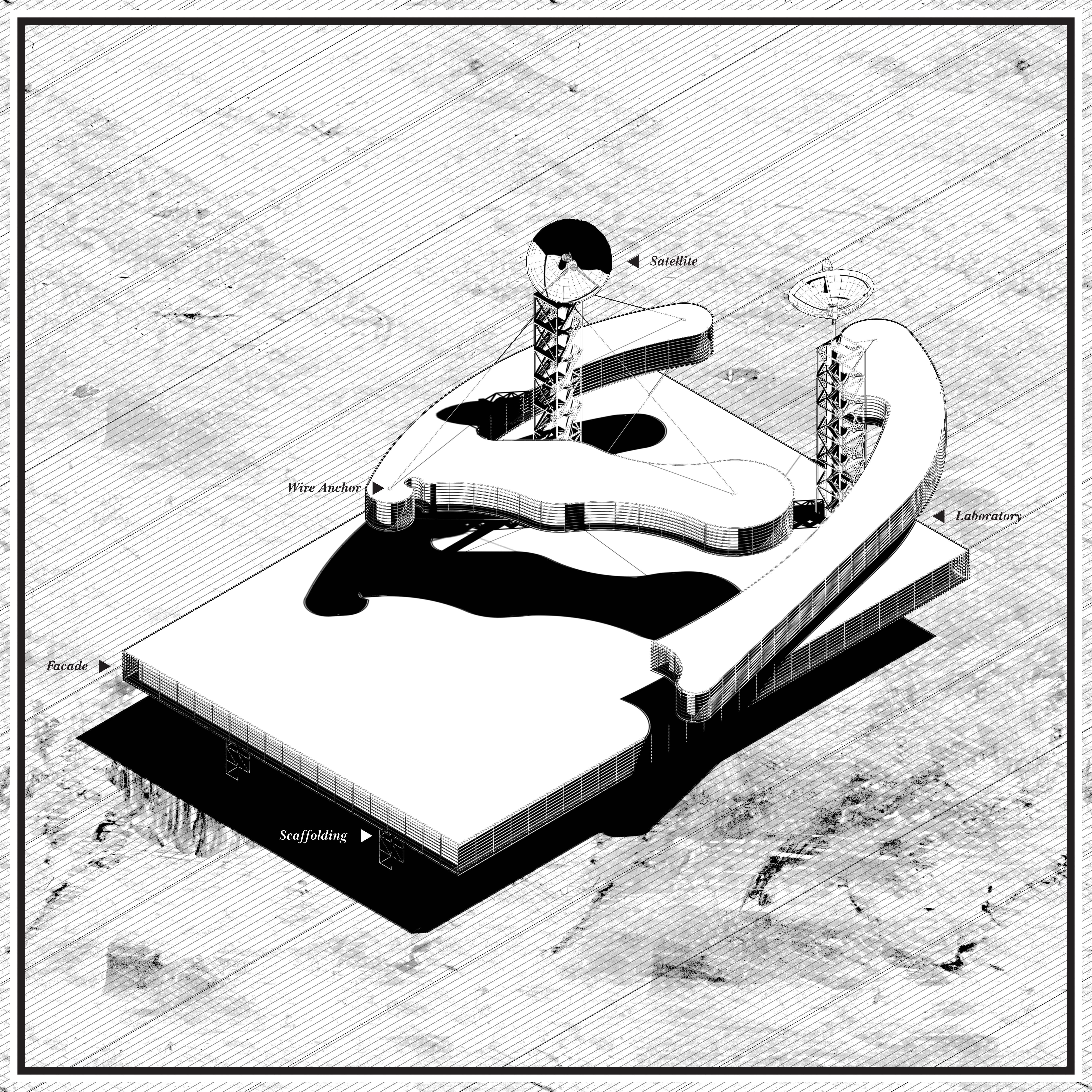

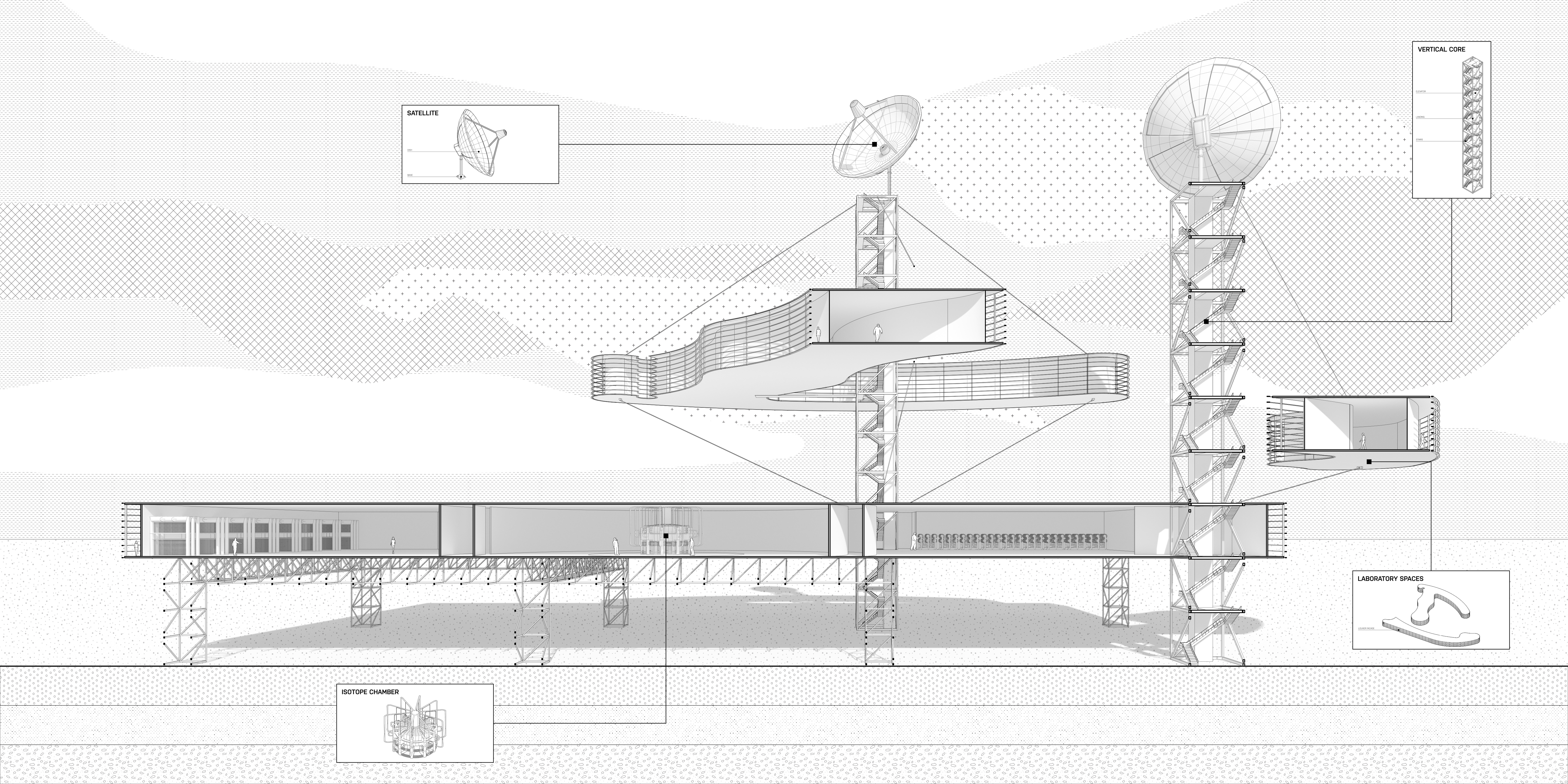

Carbo Conclusus
A System of Hope
Carbon has a fascinating function as both
the universal building block for life due to its ability to form complex,
stable molecules with itself and other elements, as well as the toxic
consequence of anthropogenic activity that is burning our planet, particularly
through the abuse of fossil fuels. Modern building-scale carbon management
technologies, such as direct air capture farms and geologic carbon
sequestration, offer promising solutions for allowing our planet to take a
deep, clean breath and provide carbon-neutral resources for our species. This
intervention proposes hortus conclusus, enclosed gardens that are maintained
and supplemented entirely by an array of deployed carbon dioxide capturing
strategies, allowing the bipolar chemical element to become a tangible,
ameliorative, and recyclable process that benefits the survival of displaced
and deprived ecologies.
The capturing of carbon dioxide from the compromised condition of the atmosphere allows for it to be integrated in controlled greenhouses as solar fuel, either densified into consumable pellets or directly pumped into greenhouses. These methods proceed to boost the plant’s photosynthesis and yields by up to 20%. Hydroponic systems, garden racks, and a vertical basket allow for visitors to escape reality and enter an oasis of sustainable byproducts. The aim of these spaces is to promote and assist an increasing biodiversity, creating an enhanced environment that grows and thrives in light of apocalyptic conditions.
Carbo Conclusus speculates a synchronous mergence of industrial archetypes, commercial plants and greenhouses, in effort to create a synthetic landscape that stimulates our current resources and practices.
The capturing of carbon dioxide from the compromised condition of the atmosphere allows for it to be integrated in controlled greenhouses as solar fuel, either densified into consumable pellets or directly pumped into greenhouses. These methods proceed to boost the plant’s photosynthesis and yields by up to 20%. Hydroponic systems, garden racks, and a vertical basket allow for visitors to escape reality and enter an oasis of sustainable byproducts. The aim of these spaces is to promote and assist an increasing biodiversity, creating an enhanced environment that grows and thrives in light of apocalyptic conditions.
Carbo Conclusus speculates a synchronous mergence of industrial archetypes, commercial plants and greenhouses, in effort to create a synthetic landscape that stimulates our current resources and practices.


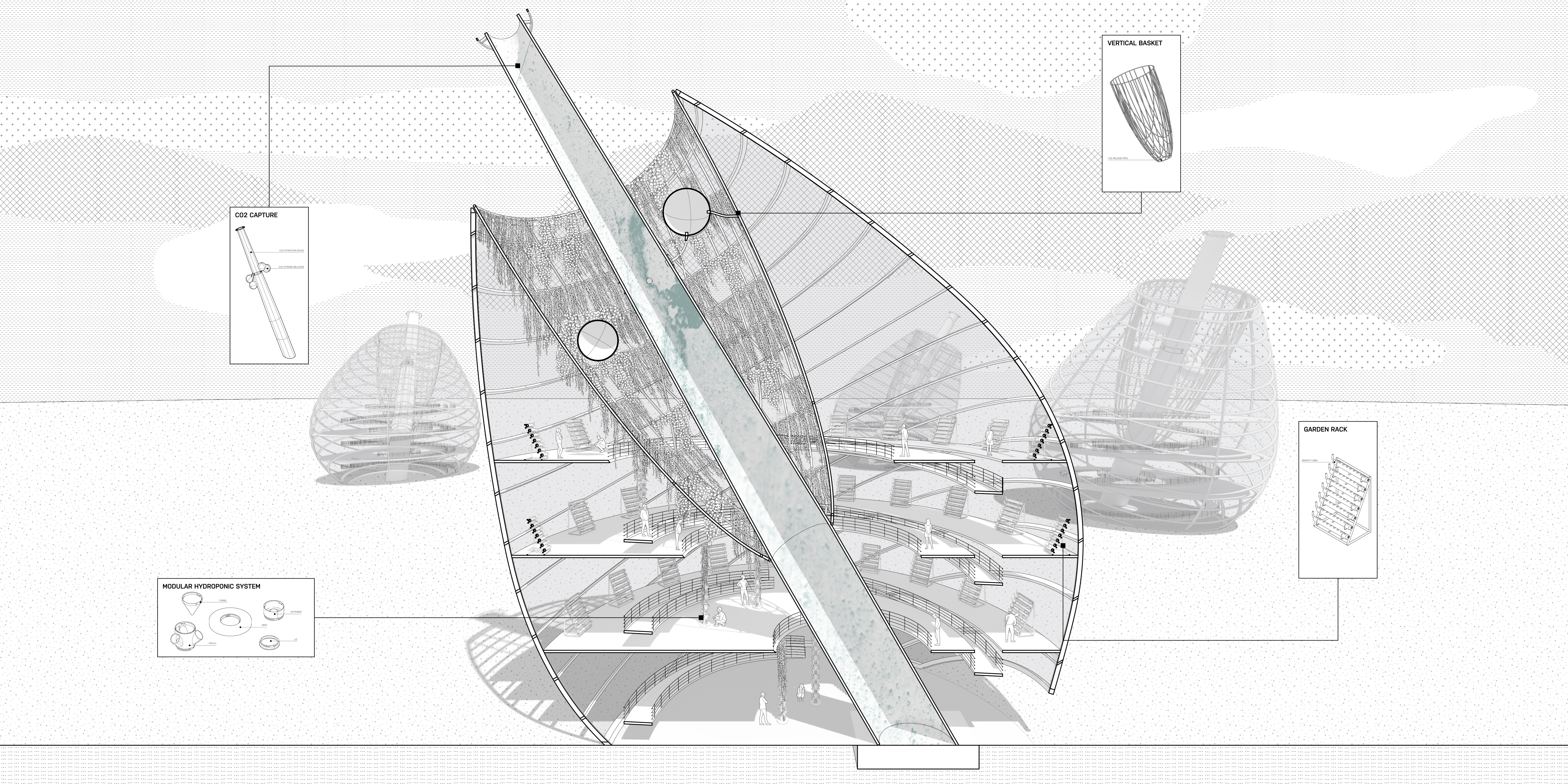



As a spatial and temporal terrain, the landscape of Chernobyl is continuously changing in unpredictable ways. Chernobyl is steered by the relationship of the site with its specific and complicated context and history – creating an evolving system instead of a static image. The five interventions take advantage of the slow, natural procedures of growth, maturity, and decay by assuming the role of systems that are guided by time and process. Their behaviors are determined by both external conditions and mechanisms of control. This systems approach goes beyond the concern of staged environments and happenings, it deals in an adaptive fashion with the larger problem of boundary concepts and planetary acupuncture. These stories represent a fraction of infinite explorations that utilize guilt and uncertainty as a tool to raise awareness, sensitivity, concern, and action that documents the relationship between flora, fauna, infrastructure, and energy. By synthesizing the cosmology of parallels between Chernobyl and today, I learned that we must be able to look at the past conditions of transformation, present conditions of neglect, and the future possibilities of resilience in order to overcome collapse and prevent voids as they happens around us, allowing us to shape and benefit the wellbeing of our world.